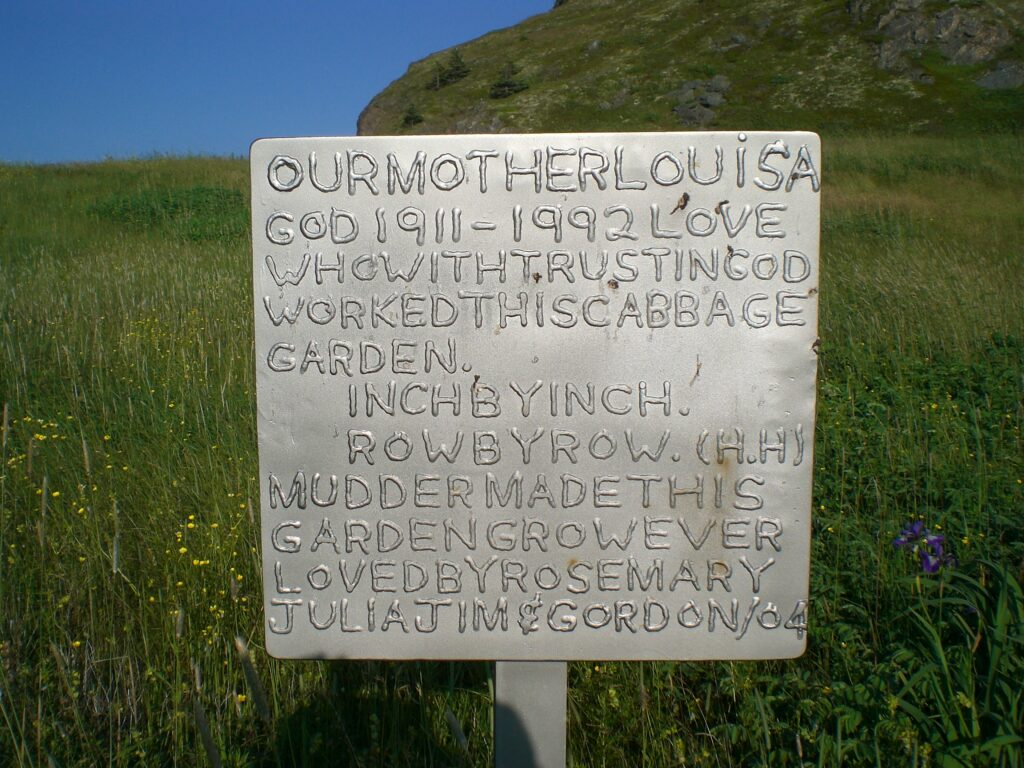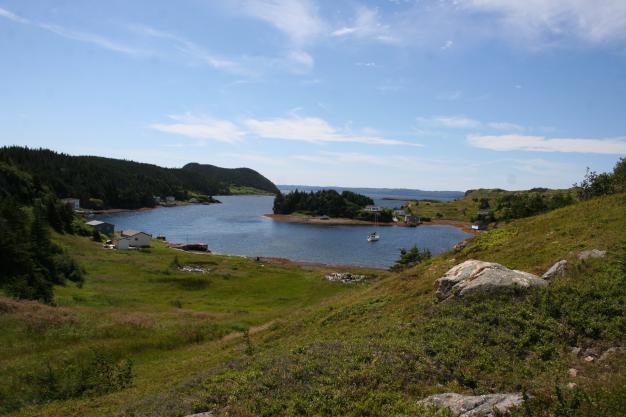Near its summit, Lance Cove Hill, on the eastern edge of Oderin’s inner harbour, has an access portal where a present-day voyager exists in both the ancient world of a once-prominent Placentia Bay community and the virtual world of modern-day connectivity. As you hike up the hill you’ll know you’ve found the Oderin “Phone Booth” when your phone suddenly comes alive with a surprisingly strong cell signal.
My hike up Lance Cove Hill in search of a phone booth followed shortly after setting Staragan’s anchor in an area of the harbour visible from the hill. My brother Ed and our friend Chris Newhook, members of Staragan’s crew that day, scaled the hill with me while continually checking for cell signals. Cell connectivity in this area of Placentia Bay is often hard to come by, so finding phone booth locations is an expected task for any sailing adventure.
I was extra anxious to find a phone booth on this particular hill, as my mother had been a teacher in Oderin in the 1930s and I was eager to reach her by phone and report our whereabouts. I was confident she’d be impressed with our voyage under sail from Jerseyside to Oderin against Placentia Bay’s prevailing, fog-laden southwesterly winds.

Near Lance Cove Hill’s summit, one of us detected that we had entered a phone booth. I made the call.
“Hello, Mom. I’m in Oderin.”
“Oderin?” she asked, sounding puzzled. “You can’t be. There are no phones there. How did you get there?”
“I’m here in my sailboat.”
“Oh my, you sailed all the way to Oderin. I didn’t think you knew enough about sailboats to do that. You’re in Oderin? Are you sure?”
Now, I’m one of three brothers. We sometimes call ourselves the three Wysemen, but our mother thinks of us as the three wise guys. She often said that one of her roles in life was keeping our inflated egos as deflated as possible. During our call she, in her 96th year, was firmly true to form.
Eventually, though still suspicious, she allowed herself to be convinced that I was in fact in Oderin and proceeded to direct my attention to erstwhile community locations that had been part of her teaching life there: the school where she taught, her boarding house, the site of the church, the homes of her friends, among others. She urged me to visit the beach on Oderin’s north shore, where the pond at its eastern end is reported to have a wooden bottom and where legend tells of treasure buried by the Frenchman LaFosse, who was suspected of being an English spy during a period when the French and English were sworn enemies. Just off the beach lies Castle Island, which is said to have a tunnel running ashore used by pirates to transfer goods from ship to shore. Rumours persist that LaFosse’s treasure lies buried in the tunnel. The infamous pirate Peter Easton is known to have been present in the area in the early 1600s – a fact that would have readily fed Oderin’s rumour-mill about pirates and piracy.
As our cell conversation came to an end and I had received her community visitation orders (similar, I think, to marching orders), I noticed that Staragan had moved off her anchored position. Driven by the afternoon’s stiff westerly winds, she was dragging her anchor toward the harbour’s eastern shore!
I descended Lance Cove Hill as fast as my legs could move. A single thought flooded my mind as I was racing toward the dinghy on the harbour shore: “Maybe Mom had a point or two about my boating skills, especially my anchoring capabilities.”
As I hurriedly launched the dinghy while doubting that I could reach Staragan before she brought up on the shore, an open motorboat seemingly appeared out of nowhere. Its operator adeptly grabbed Staragan’s anchor rode and pulled her safely to the centre of the harbour.
From his family’s former premises in Oderin harbour, the very observant Phonse Murphy had noticed that Staragan was being knocked off her anchored position and quickly took action to save her most thankful skipper the embarrassment of a harbour grounding.

With Staragan eventually re-anchored, the beach was visited and Castle Island was observed, but neither treasure nor tunnel entrance was found, and the dark water of the pond hid its wooden bottom. Unusual metal signs with raised lettering, unknown to my mother since they were placed after her time in Oderin, were encountered throughout the former community. Defying Placentia Bay’s harsh conditions, they seem intended as permanent records of Oderin’s former residents and how they lived. And, like tunnels, treasures, piracy and wooden bottoms, the signs would certainly make for interesting conversation during my next cell call from the Oderin Phone Booth on Lance Cove Hill.
Mariner’s Guide to Oderin Harbour

Hydrographic Charts: 4615 (47°17’22.4″N 54°48’39.5″W)
Harbour Entry: When entering and transiting Oderin harbour en route to the inner harbour, mariners should be guided by the sequence of starboard-hand (red) markers. Data on electronic charting systems has been observed to vary from actual hydrographic features in the harbour area. Mariners are advised to exercise caution when navigating at night or in conditions of reduced visibility.
Docking/Anchoring: No public wharves are available and private wharves have minimal depths alongside. There are some private moorings but permission to use them should be obtained prior to occupancy.
Notes: Cell phone connectivity was obtained on the eastern slope of Lance Cove Hill (approximate coordinates: 47.294726, -54.800395).
See Oderin on the Coastal Marine Informatics website for more community and marine-related information. – By Jim Wyse









